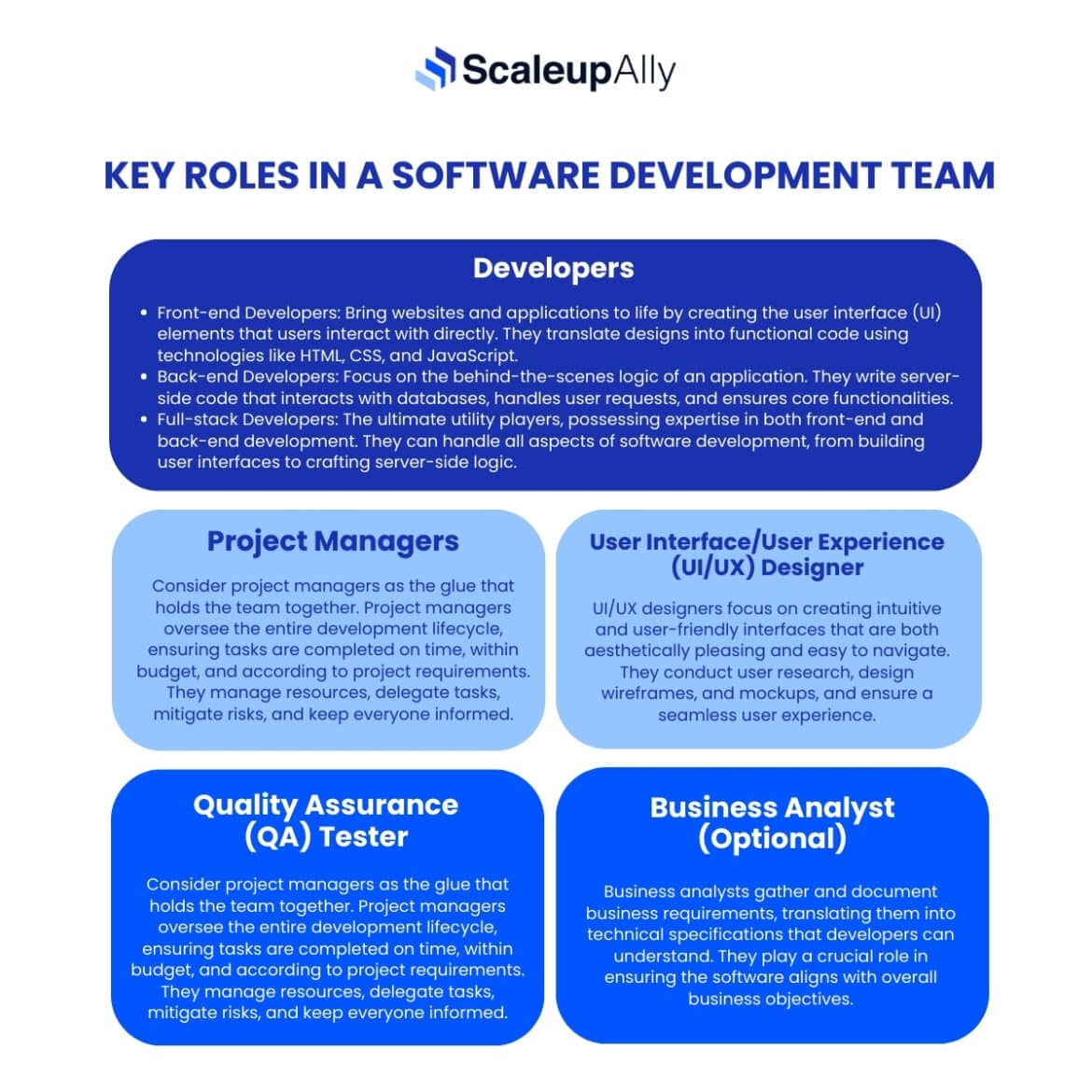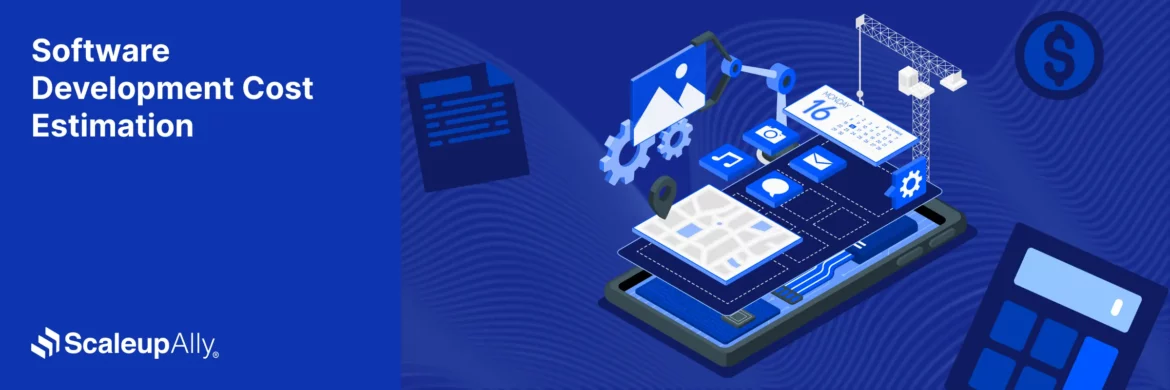
How to Choose the Right Software Development Team Structure?
Suprabhat Sen | June 30, 2024 , 12 min read
Table Of Content
When it comes to software development, the team you assemble is just as important as the code they write. But with so many roles, how do you decide how to structure your team for maximum efficiency and success?
In a nutshell, your software development team structure defines who does what and how they work together. It encompasses the roles within your team (developers, designers, testers, etc.) and how they collaborate throughout the development process.
Choosing the best software development team structure isn’t a one-size-fits-all proposition. It can make all the difference between a project that runs smoothly and delivers on time, and one that grinds to a halt, missing deadlines and exceeding budgets.
In this blog post, we’ll explore how to structure a software development team, the factors to consider when making your choice, and how to pick the perfect team to turn your vision into reality.
4 Common Team Structures in Software Development
The choice of team structure significantly impacts how your software development project unfolds. Here’s a breakdown of some of the most common approaches, along with their pros, cons, and ideal use cases:
1. Triad Structure (Feature Teams)
This agile-friendly structure focuses on small, cross-functional teams with representatives from design, development, and product ownership. Each “triad” owns a specific feature or product increment, fostering close collaboration and rapid iteration.
Advantages:
- Empowerment and ownership: Team members have a clear understanding of the entire development cycle for their assigned feature.
- Agility and responsiveness: Triads can adapt quickly to changing requirements due to their close collaboration and focus on specific functionalities.
- Improved communication: Reduced team size encourages clear and direct communication within the triad.
Disadvantages:
- Limited specialization: Team members may not have in-depth expertise in every area.
- Resource limitations: Smaller teams might struggle with complex projects requiring diverse skill sets.
- Potential for silos: If not managed well, communication across triads might be hindered.
Best for: Agile development projects, rapid prototyping, smaller applications with well-defined features.
2. Generalist Structure
This structure relies on team members with broad skillsets who can handle various development tasks. They can work independently on diverse aspects of the project, fostering a sense of ownership.
Advantages:
- Flexibility and adaptability: Generalist teams can adapt to changing requirements and handle unexpected roadblocks.
- Cost-effective: Requires fewer personnel compared to specialist structures.
- Strong team spirit: Encourages collaboration and knowledge sharing across the team.
Disadvantages:
- Potential knowledge gaps: Team members might not have the deep expertise needed for complex technical challenges.
- Quality control concerns: Consistency in coding style and best practices might be a concern.
- Slower development: Generalists might take longer to complete specific tasks compared to specialists.
Best for: Smaller projects with well-defined requirements, startups with limited resources, fostering a sense of shared responsibility amongst team members.
3. Specialist Structure
This structure brings together experts in various development areas. Each team member possesses deep knowledge in their specialization, leading to high-quality code and efficient development processes.
Advantages:
- High-quality development: Specialists can handle complex tasks efficiently and follow best practices in their area.
- Focus and efficiency: Clear roles and responsibilities minimize redundancy and expedite development.
- Knowledge sharing: Specialists can mentor others and foster a culture of continuous learning.
Disadvantages:
- Communication challenges: Requires strong coordination between specialists to ensure a cohesive product.
- Increased costs: Hiring and retaining specialists can be expensive.
- Less adaptability: Adapting to changing requirements or unforeseen technical challenges might be slower.
Best for: Large, complex projects with well-defined technical requirements, projects requiring a high degree of expertise in specific areas.
4. Hybrid Structure
This structure combines elements of the specialist and generalist approaches. It leverages the strengths of both – generalists for core development tasks and specialists for complex technical areas.
Advantages:
- Flexibility and expertise: Hybrid teams can handle diverse project complexities while maintaining efficiency.
- Balanced skillsets: Offers a good balance between cost-effectiveness and deep knowledge.
- Knowledge transfer: Generalists can learn from specialists, fostering a well-rounded team.
Disadvantages:
- Management complexity: Requires careful coordination to ensure smooth collaboration and knowledge sharing.
- Potential for communication gaps: Clear communication channels are essential to bridge potential gaps between specialists and generalists.
Best for: Projects of varying complexity, requiring both diverse skillsets and in-depth expertise in specific areas.
How to Choose the Right Structure for Your Project?
You’ve explored the various team structures – triads, generalists, specialists, and hybrids – each with its own strengths and weaknesses. But how do you pick the perfect fit for your project? Here are some key factors to consider when choosing a software development department structure:
1. Project Complexity
- Simple Projects: Generalist or Triad structures can handle well-defined projects with limited technical complexities.
- Complex Projects: Opt for a Specialist or Hybrid structure to leverage deep expertise and ensure high-quality development.
2. Project Size and Budget
- Smaller Projects: Generalist or Triad structures might be ideal due to their cost-effectiveness and ability to function with fewer team members.
- Larger Projects: Specialist or Hybrid structures can handle the workload and diverse skillsets required for large-scale software development, but be prepared for potentially higher costs.
3. Development Methodology
- Agile Development: Triad structures excel in agile environments due to their focus on rapid iteration and close collaboration.
- Waterfall Development: Specialist structures can streamline development under the Waterfall methodology’s structured approach. However, hybrid structures can also be effective if some flexibility is needed.
4. Team Experience and Skillsets
- Highly Skilled Teams: Specialist or Hybrid structures can leverage existing expertise within the team.
- Less Experienced Teams: Generalist or Triad structures might be a better fit, fostering a collaborative environment where team members can learn from each other.
There’s no one-size-fits-all answer. The best team structure for your project is the one that aligns with your specific needs and goals.
Carefully consider these factors, and don’t be afraid to get creative! Sometimes, a hybrid approach that blends elements from different structures can be the most effective solution.
How To Build An Ideal Software Development Team?
The ideal software development team isn’t just about structure; it’s about the right people with the right skills working together effectively. Here’s how you can build that dream team:
Step 1: Understand Your Business Requirements
Before recruiting anyone, it’s crucial to thoroughly understand your project’s goals and functionalities. Begin by identifying the problem you aim to solve and the specific needs it addresses.
Determine your target audience and understand their preferences, behaviors, and challenges. A clear and detailed comprehension of your business needs will not only shape your project’s direction but also guide your hiring decisions.
This foundational knowledge ensures you bring on board the right talent with the necessary skills and expertise to achieve your objectives effectively and efficiently.
Step 2: Create a Project Plan
When embarking on a new project, it’s essential to outline your project timeline, budget, and development methodology, whether Agile or Waterfall.
Start by mapping out key milestones and deadlines to create a clear timeline that keeps your team on track. Define your budget by considering all potential costs, including development, testing, and post-launch support.
Choosing the right development methodology is crucial: Agile offers flexibility and iterative progress, ideal for dynamic projects, while Waterfall provides a structured approach with clear, sequential stages.
This planning phase will help you determine the optimal team size and necessary skills, ensuring you have the right mix of developers, designers, and project managers.
By establishing this foundation, you can set realistic expectations, manage resources effectively, and achieve your project goals efficiently.
Step 3: Begin the Hiring Process
Now you can start recruiting! Look for individuals with the technical skills necessary for your project, ensuring they have expertise in the specific technologies and methodologies required.
This could include proficiency in programming languages, software development frameworks, data analysis tools, or any other specialized knowledge pertinent to your goals. However, it’s crucial not to overlook the importance of soft skills.
Effective communication is essential, as team members need to articulate their ideas clearly and listen to others. Collaboration skills are equally important; your team should work cohesively, leveraging each member’s strengths and supporting one another. Problem-solving abilities are critical, as projects often encounter unexpected challenges that require innovative and strategic solutions.
Step 4: Assign Roles and Responsibilities
Once your team is assembled, it is crucial to clearly define each member’s role and responsibilities within the chosen structure (such as Triad, Specialist, etc.).
This step ensures that everyone understands their specific contributions to the project’s success and facilitates smooth collaboration. By outlining distinct roles and expectations, team members can focus on their tasks, leverage their strengths, and avoid overlap or confusion.
This clarity not only enhances individual performance but also fosters a cohesive team dynamic, ultimately driving the project toward its goals efficiently and effectively.
Step 5: Begin Onboarding
Don’t just throw new hires into the fire! Invest in a well-structured onboarding process to set them up for success. Start with comprehensive introductions to the team to foster a sense of belonging and facilitate collaboration.
Follow this with detailed project overview sessions that provide context and clarity on their roles and responsibilities within the project.
Finally, incorporate technical training tailored to the specific needs of your project, ensuring that new hires have the necessary skills and knowledge to contribute effectively. By taking these steps, you can enhance productivity, reduce turnover, and build a more cohesive and capable team.
Bonus Step: Foster a Collaborative Culture
An ideal software development team thrives on open communication, knowledge sharing, and a sense of shared responsibility. Encourage regular team meetings, code reviews, and opportunities for mentorship to create a supportive and collaborative environment.
By following these steps and carefully considering your project’s needs, you can build an ideal software development team that effectively translates your vision into a high-quality software product.
Key Roles in a Software Development Team

The success of a software development project hinges on a well-coordinated team with diverse skillsets. Here’s a breakdown of a software development team’s roles and responsibilities:
1. Developers
- Front-end Developers: Bring websites and applications to life by creating the user interface (UI) elements that users interact with directly. They translate designs into functional code using technologies like HTML, CSS, and JavaScript.
- Back-end Developers: Focus on the behind-the-scenes logic of an application. They write server-side code that interacts with databases, handles user requests, and ensures core functionalities.
- Full-stack Developers: The ultimate utility players, possessing expertise in both front-end and back-end development. They can handle all aspects of software development, from building user interfaces to crafting server-side logic.
2. Project Manager
Consider project managers as the glue that holds the team together. Project managers oversee the entire development lifecycle, ensuring tasks are completed on time, within budget, and according to project requirements. They manage resources, delegate tasks, mitigate risks, and keep everyone informed.
3. User Interface/User Experience (UI/UX) Designer
UI/UX designers focus on creating intuitive and user-friendly interfaces that are both aesthetically pleasing and easy to navigate. They conduct user research, design wireframes, and mockups, and ensure a seamless user experience.
4. Quality Assurance (QA) Tester
QA testers test the software at every stage of development, identifying and reporting bugs and functionality issues. They ensure the final product is free of errors and meets the required quality standards.
5. Business Analyst (Optional)
Business analysts gather and document business requirements, translating them into technical specifications that developers can understand. They play a crucial role in ensuring the software aligns with overall business objectives.
Conclusion
In this blog post, we’ve explored software development team structures. We unpacked the different ways these teams can be set up. – triads, generalists, specialists, and hybrids – each offering unique advantages and considerations. We looked into factors that influence your choices, like project complexity, size, and development methodology.
The right software development team structure is the foundation for a successful development project. It fosters clear communication, efficient workflows, and a collaborative environment where everyone plays a role.
By carefully considering your specific needs and goals, you can build the ideal team to translate your vision into a high-quality software product.
However, picking the right team structure in software development can be tricky.
Don’t do it by yourself! At ScaleupAlly, we have the expertise to help you assess your project requirements, team skillsets, and development goals. We can guide you toward the optimal team structure that sets you on the path to software development success. Contact us today and let’s build your dream team together!
Frequently Asked Questions (FAQs)
Q: What are the different types of software development projects?
There are many! From web and mobile applications to enterprise software and video games, software development projects cater to diverse needs and industries.
Q: What are the benefits of using a structured approach to software development?
Structured approaches like Agile or Waterfall promote clear communication, efficient workflows, and reduced risk of errors. They help keep projects on track and ensure high-quality results.
Q: How much does it cost to develop software?
Costs vary depending on project complexity, size, and team structure. Consider factors like development hours, team rates, and additional resources needed for an accurate estimate.
Q: What are some red flags to watch out for when choosing a software development team structure?
Red flags include a structure that doesn’t align with project complexity, a mismatch between team skills and project demands, or a lack of clear communication channels within the chosen structure.
Related Blogs

Top 20 Emerging Technologies of 2026
Discover the top 20 emerging technologies of 2026. Explore which innovations are driving change across healthcare, finance, manufacturing, and other crucial industries.
ScaleupAlly Team
Dec 16 ,
9 min read

Software Development Timeline: Phases, Duration & Estimation Guide
Understand the software development timeline with phase durations, key factors, hidden delays, and practical methods to estimate project time.
Suprabhat Sen
Nov 29 ,
16 min read

Software Development Cost Estimation Guide: What’s Included & What Affects the Price
Explore software development cost components, major pricing factors, and practical estimation methods to plan your project accurately from start to finish.
Suprabhat Sen
Nov 29 ,
14 min read


